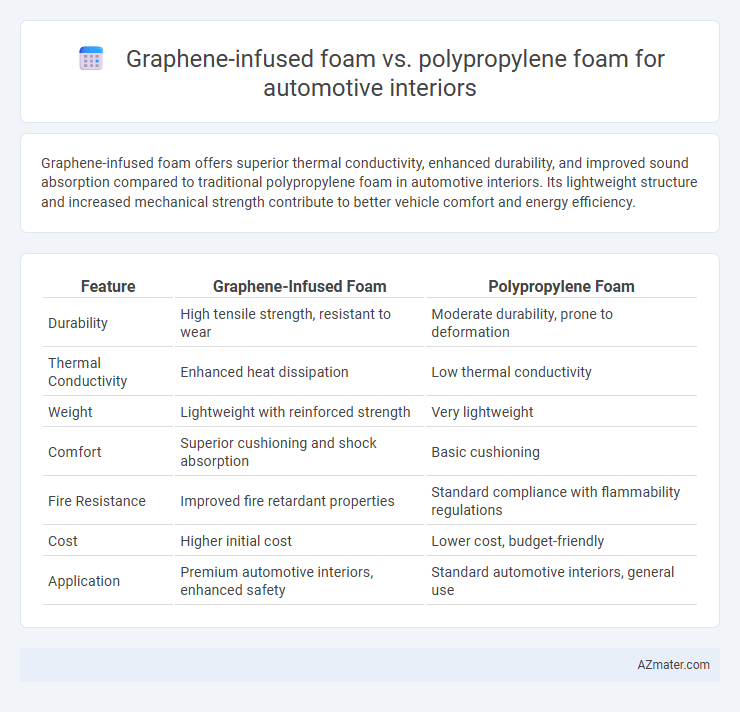Graphene-infused foam offers superior thermal conductivity, enhanced durability, and improved sound absorption compared to traditional polypropylene foam in automotive interiors. Its lightweight structure and increased mechanical strength contribute to better vehicle comfort and energy efficiency.
Table of Comparison
| Feature | Graphene-Infused Foam | Polypropylene Foam |
|---|---|---|
| Durability | High tensile strength, resistant to wear | Moderate durability, prone to deformation |
| Thermal Conductivity | Enhanced heat dissipation | Low thermal conductivity |
| Weight | Lightweight with reinforced strength | Very lightweight |
| Comfort | Superior cushioning and shock absorption | Basic cushioning |
| Fire Resistance | Improved fire retardant properties | Standard compliance with flammability regulations |
| Cost | Higher initial cost | Lower cost, budget-friendly |
| Application | Premium automotive interiors, enhanced safety | Standard automotive interiors, general use |
Overview of Automotive Interior Foams
Graphene-infused foam offers superior thermal conductivity, enhanced durability, and improved mechanical strength compared to traditional polypropylene foam used in automotive interiors. Polypropylene foam remains popular due to its lightweight nature, cost-effectiveness, and resistance to chemicals and moisture, providing reliable cushioning and insulation. The integration of graphene in automotive interior foams aims to elevate performance by increasing impact resistance and acoustical properties while maintaining lightweight characteristics essential for vehicle efficiency.
What is Graphene-Infused Foam?
Graphene-infused foam is a cutting-edge material that integrates graphene, a single layer of carbon atoms known for its exceptional strength, conductivity, and lightweight properties, into traditional foam matrices. In automotive interiors, this advanced foam enhances durability, thermal regulation, and vibration dampening compared to conventional polypropylene foam. Its superior mechanical strength and thermal conductivity make graphene-infused foam an innovative choice for improving comfort and longevity in vehicle seating, door panels, and dashboard components.
Key Properties of Polypropylene Foam
Polypropylene foam offers exceptional lightweight density, excellent thermal insulation, and superior impact absorption, making it a preferred material for automotive interiors. Its chemical resistance, moisture resistance, and high fatigue strength ensure durability and long-term performance under varying environmental conditions. Compared to graphene-infused foam, polypropylene foam provides cost-effective manufacturing and recyclability advantages without compromising structural integrity or comfort.
Comparative Thermal Insulation Performance
Graphene-infused foam exhibits superior thermal insulation performance compared to polypropylene foam due to its enhanced thermal conductivity control and reduced heat transfer properties. This advanced foam maintains interior cabin temperatures more effectively, leading to improved energy efficiency in automotive climate control systems. Polypropylene foam, while lightweight and cost-effective, offers lower thermal resistance, making graphene-infused alternatives preferable for high-performance automotive interiors.
Durability and Longevity: Graphene vs Polypropylene
Graphene-infused foam exhibits superior durability and longevity compared to polypropylene foam in automotive interiors due to graphene's exceptional tensile strength and resistance to wear, ensuring the foam maintains structural integrity under continuous stress. Polypropylene foam, while cost-effective and lightweight, degrades faster when exposed to heat, UV radiation, and mechanical pressure, resulting in reduced lifespan and frequent replacements. The integration of graphene enhances foam elasticity and thermal conductivity, significantly prolonging the material's performance in harsh automotive environments.
Weight and Density Considerations
Graphene-infused foam offers significantly lower density compared to polypropylene foam, enhancing vehicle fuel efficiency by reducing overall weight without compromising structural integrity. The incorporation of graphene nanoparticles increases mechanical strength, enabling thinner foam layers that further decrease mass in automotive interiors. Polypropylene foam, while lightweight and cost-effective, typically exhibits higher density and reduced durability under stress compared to graphene-enhanced alternatives.
Safety and Flame Resistance
Graphene-infused foam offers superior flame resistance and enhanced thermal stability compared to traditional polypropylene foam, making it a safer choice for automotive interiors subjected to high temperatures and fire hazards. Its improved mechanical strength and reduced flammability significantly lower the risk of toxic smoke emission during combustion, enhancing passenger safety. Polypropylene foam, while lightweight and cost-effective, generally lacks the advanced flame-retardant properties and structural reinforcement provided by graphene integration.
Environmental Impact and Recyclability
Graphene-infused foam offers enhanced durability and thermal conductivity while maintaining lightweight properties, which can lead to reduced vehicle fuel consumption and lower carbon emissions over the vehicle's lifecycle compared to traditional polypropylene foam. Polypropylene foam is widely recyclable and benefits from established recycling infrastructure, but graphene-enhanced composites currently face challenges in recyclability due to the integration of nanomaterials that complicate separation processes. Evaluating the environmental impact, polypropylene foam typically results in lower end-of-life waste concerns, whereas graphene-infused foam may require advanced recycling technologies to mitigate potential environmental risks associated with nanomaterial residues.
Cost Analysis: Production and Implementation
Graphene-infused foam offers enhanced durability and thermal conductivity for automotive interiors but incurs significantly higher production costs due to expensive raw materials and complex manufacturing processes. Polypropylene foam remains a cost-effective choice, benefiting from well-established supply chains and simpler fabrication methods, resulting in lower implementation expenses. While graphene-infused foam promises performance advantages, polypropylene foam provides a more economical solution for large-scale automotive interior applications.
Future Trends in Automotive Foam Technology
Graphene-infused foam offers superior strength, enhanced thermal conductivity, and improved durability compared to traditional polypropylene foam, making it a promising material for future automotive interiors. Innovations in nanotechnology enable graphene-enhanced foams to provide lightweight solutions with better sound absorption and fire resistance, addressing critical automotive safety and comfort standards. The shift towards electric vehicles (EVs) and increasing demand for sustainable, high-performance materials drive the adoption of graphene-infused foam in next-generation automotive interior applications.

Infographic: Graphene-infused foam vs Polypropylene foam for Automotive interior
 azmater.com
azmater.com